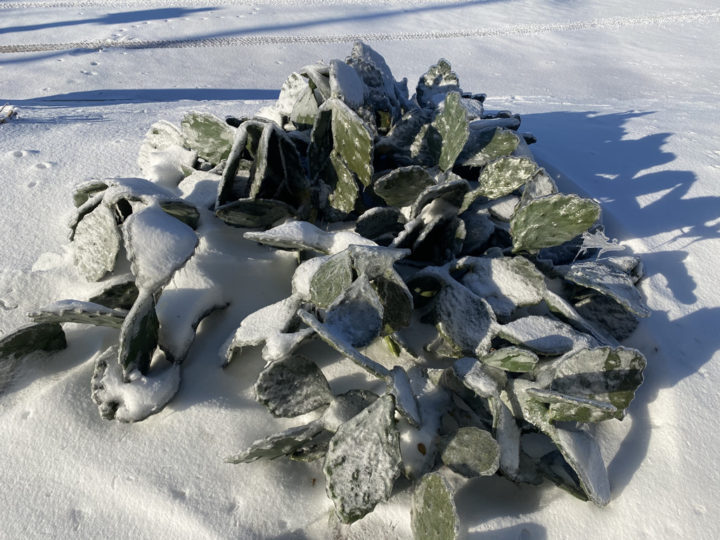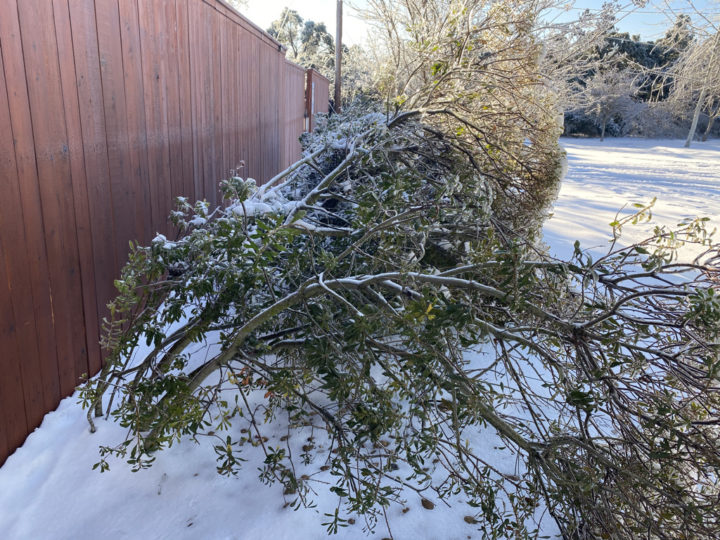What happens to the Texas Landscape when it gets this cold?
Background Information: This was written in mid-February 2021 during a “winter vortex”. You may have heard of the movie – The Perfect Storm – well that was about a different storm. Similar though. Central Texas saw multiple days under snow. While this may be a normal occurrence in Kansas, Chicago or Moscow, we Texans nearly had a cow (Texas term) – neither the people nor the landscape (or the power distribution authorities) are prepared for such events (except for the preppers – good on you). This is an attempt to educate us and prepare us for the inevitable landscaping pain ahead.
It’s been 30 years since Austin had a storm like this – In the late 80’s or early 90’s (my dad couldn’t remember) there was a storm that took Austin into the teens or lower for multiple days. The region lost a lot of plants, including some very mature palm trees and large areas of St. Augustine.
Some things to remember about the cold
Microclimates. Just as in life…all plants and all landscape locations are not created equal. Some microclimates (hyper localized areas) are just colder. Example: At one of our employee’s house the faucet on the side of the house freezes faster than the faucets on the front or back. This is because 1) it gets a greater wind chill, 2) it is less insulated, and 3) the winter gods despise it (our guess). Likewise, the plants in that area will get colder. They will have more damage than areas that are more protected.
Small things matter. Additionally, degrees and hours matter. A slight temperature difference (up or down) is often the difference between life, damage or death for a plant or areas of turf.
Mama Nature. Just like any good mom – mother nature doesn’t have to explain herself. She gives and takes. And it won’t always make sense. Some stuff will live. Other vegetation won’t. If you want us to make up a reason for why, we can, but sometimes there isn’t a good reason.
Plants and Trees
For simplicity’s sake, I am going to put plants and trees into three categories.
Category 1: Plants and trees that get cold, but normally rebound
What is going to be fine?
- Cold climate natives. Plants and trees that are native to colder climates are excited to show you how to handle this weather (like your aunt that lives in Chicago).
- Larger hardwoods. These freak storms happen every several decades. Oaks and other hardwoods live much longer than a few decades because they can survive moments like these and worse. You will see some limbs break from the weight and you should be careful to treat these breaks with care. Breaks are often where a tree gets disease so these should be cleaned up and, in some cases, painted for protection.
- Hardy native shrubs that are protected. Many of the native plants and shrubs that are in more protected areas will be just fine.
Category 2: “If they die, then they die” (Voice from Rocky 4)
Which plants are a toss-up?
- Most of your perennials fit into this category. Lantanas, sages, pride of Barbados, turk’s cap, etc. We will lose some perennials depending on their location, insulation (mulch) and how they were watered. Some of these will survive. If you started to see some growth come back in early February (remember we had a week in the 80s), that new growth is going to die.
- Xeric plants like cacti, agaves and yuccas surprisingly may handle the cold. We often forget that deserts can get really cold. These plants will often make it through an event like this. But, again, there could be some substantial damage.
- Some of the larger shrubs will get some damage. You will see sections die – this will be an aesthetic problem. You could see half of a mature foundation shrub die.
Category 3: Dead as a doornail…or mostly dead (like The Princess Bride) 
The sad truth – a lot of plants are going to die. We haven’t had weather like this in Texas in decades, and we likely won’t again for another few decades (or until next year).
So, ultimately, what is going to die and what is going to survive? We don’t know. We will have to wait to see.
- Your highest risk plants will be the plants native to tropical climates. Your palms may not make it – even the really mature 25-year-old palms.
- Anything extremely exposed to the elements. Gone.
- Almost everything that has bad breaks. There was a lot of ice build-up which will cause some serious breaks in limbs. If your trees haven’t been trimmed in a while then this is a risk.
Turf Grass
Turf areas most at risk of damage courtesy of our friends at Emerald Lawns:
- On north-facing slopes.
- Under trees or around the foundation of the house (which has a tendency to stay green or active even during winter months)
- St. Augustine is by far the most susceptible for winter damage
- Areas with heavy traffic or compaction (especially traffic while the ice and snow were present)
- Newly established lawns
We are going to see some significant “winter kill”. Winter kill is a relative term for exactly what it sounds like…Grass that is killed by the cold. So, what is going to die and what will make it?
Just like plants, it is going to depend on the the microclimate, the environmental factors, and the specific type of turf.
Factors that will matter in survival and damage: Does the area drain well? Does the area receive winter sun? (Soil temperature over the next several days will matter). Is the soil compact? Is it heavily shaded? How established is the turf? Did someone walk/drive through it while it was frozen? Etc.
Ironically, the snow may insulate the turf. If you have a bunch of little kids running around on the frozen blades (like us) that may damage the turf. Worth it? Probably… for the laughter and joy from the little faces. We may regret saying this.
Turf grass in Central Texas is typically chosen for its heat hardiness – not its cold hardiness. Bermuda grass, St Augustine Grass and Zoysia are all very good at surviving in the heat (with the right care). They will deal with the cold with varying success.
Most zoysia will be fine. This is primarily because it grows via rhizomes (underground). This will give it more natural protection.
St. Augustine is less certain. It grows via stolons – the above ground crawlers. We anticipate seeing some damage.
Typically, we would advocate for Bermuda to handle a nuclear war. But cold…perhaps not. It also grows via stolon and we will see quite a bit die.
Irrigation
Irrigators and plumbers have a low-key rivalry. It’s funny – they each think the other inferior. But, they do much of the same thing – get water from a source to the desired location, in the proper quantity, at the right time. (Fortunately for us irrigators – we don’t have to figure out how to make the yucky stuff disappear).
We make the comparison because much of the real property damage in a freeze like this will come in the pipes. When water freezes and expands, it tends to destroy pipes.
The most commonly broken irrigation item in a freeze: the backflow preventor. When you get your house in order, everything thaws for a day or two and the temperature is back up to 65 degrees next week, flip on the irrigation system and make sure your backflow didn’t rupture.
What to do now…
Wait. Let’s see what makes it and what doesn’t.
Replace it or not? It’s been 30 years since we had a storm like this. Will it be another 30 years? Of course, we don’t know. Each situation and yard will be different. Some people will get lucky and have little to no damage to their landscape. Many will see some big losses.
Hopefully we have helped you answer: What happens to the Texas Landscape when it gets this cold? If not, please reach out.
Want to know more about our team? Visit here.


